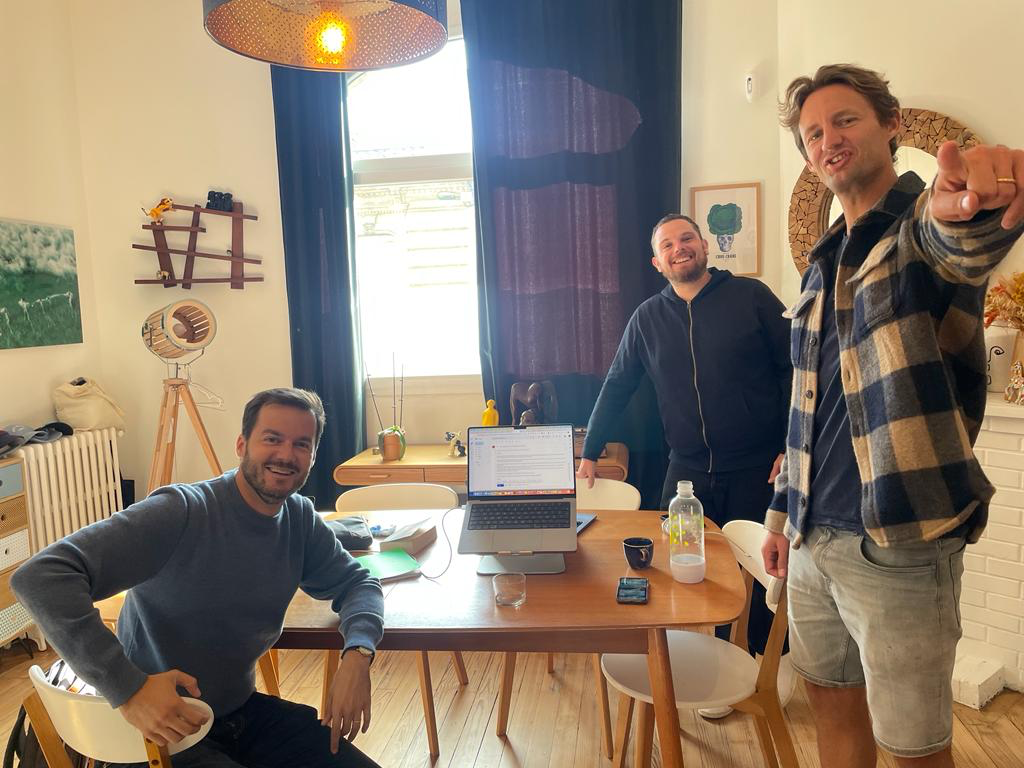
My name is James, and what follows is a detailed chronicle of three transformative months I spent with Yoann, diving headfirst into the chaotic yet exhilarating world of startups. This period redefined not just our careers but our very approach to entrepreneurship.
Our journey began when we decided to leave our jobs at a startup that, despite its size and ambitions, was struggling to make sales. This startup already had three co-founders and about fifteen employees, yet it had not achieved its Product-Market Fit (PMF).
Yoann joined the startup three years after its inception, and I came on board a year after him. We were both recruited by the co-founder and CEO of the startup, where we quickly built strong relationships with new clients we actively pursued.
Our commitment to the success of the project was deep. We were so immersed in driving the company’s pivot that we didn’t fully grasp how much our clients perceived us as leading the venture. One day, a revealing question from a client sparked a significant realization: she asked who the third founder was, assuming Yoann and I were the primary drivers behind the startup. This moment was the catalyst for a series of reactions and led us to rethink our roles and the potential beyond this setting. We saw that there was a way for our energy to become a great venture. Our belief in our complementary skills — Yoann’s technical prowess and my business acumen — fueled our decision to leave and start something of our own.
“Luck is not a superpower that some have more than others, it is an above-average attitude of capitalizing on the unexpected and recycling difficulties.” — Philippe Gabilliet
Fresh out of school, my approach was cautious and critical, encapsulated by a pervasive “Yes, but…” (“oui mais” in French) attitude. I was fixated on finding flaws and obsessed with the idea of launching the perfect project. However, the practical realities of business life gradually unveiled a more proactive side of me, one that confidently says, “Go for it” (“Allez vas-y” in French).
As I immersed myself in the dynamic world of startups and engaged with seasoned entrepreneurs and decisive leaders, I came to a profound realization. The familiar adage, “An idea is worth nothing without execution,” began to resonate deeply with me. This exposure taught me the indispensable value of action and implementation in the entrepreneurial landscape.
I learned that true innovation isn’t just about having groundbreaking ideas; it’s about identifying genuine problems that need solving. It involves developing practical solutions and being prepared to iterate those solutions countless times. Each iteration brings you closer to refining a product or service that truly meets the needs of its users.
Reflecting on my journey and lessons learned, I would now articulate the proverb a bit differently: “An idea is worth nothing without a true pain to solve.” This new perspective underscores the importance of grounding innovations in real-world needs, ensuring that they address genuine challenges and deliver tangible benefits.
Unsure of the exact product we wanted to create, we embraced the startup studio model. This approach allowed us to systematically generate and test ideas. Our process was organized into two-week sprints, dedicating 80% of our efforts to a primary idea and the remaining 20% to exploring secondary concepts. This structure kept us focused yet flexible enough to pivot as needed.

Yoann, with his knack for technology and experience as a serial entrepreneur, was instrumental in rapidly developing prototypes. Yoann was the wizard behind our prototypes, bringing ideas to tangible forms overnight. I handled the business side, engaging with a network of experts, potential customers, and investors — building a network that would be crucial for our success.
We faced numerous challenges from the outset. One of our early setbacks was a legal challenge from major tech companies over a brand name we had registered. Despite these hurdles, we persisted, fueled by the adrenaline and fast pace that defined our startup environment.
Our strategy involved sharing our top three ideas (Gold, Silver & Bronze) with our network, refining them based on the feedback received. The practice was enlightening but also brutally honest at times. One of our most disheartening moments was when we distributed 150 surveys to test one of our concepts and received only ten responses, none particularly encouraging.
However, Eric Larchevèque taught us that a good idea is one that others want to steal, which encouraged us to keep sharing and refining our concepts openly.
However, we learned from Eric Larchevèque that a good idea is one that others want to steal, which encouraged us to keep sharing and refining our concepts openly.
During these months, we absorbed every piece of advice we could get. We began to see our ideas as fluid, ever-evolving based on market needs and feedback.
We also drew inspiration from various experts and mentors. Thomas France, once told us that “the first idea is always crap,” a piece of advice that kept us from becoming too attached to early concepts and pushed us to continually innovate.
Our real breakthrough came from a shift in perspective. After an especially disappointing feedback session, where it became clear that our current ‘great idea’ had no market, I found solace in a long discussion with my wife, Margaux. She had compiled a list of the top 150 startup ideas from the US and China, which we painstakingly reviewed. This exercise, though overwhelming, was enlightening. It led to a critical pivot: instead of looking for ideas, we began searching for problems, a strategy that proved to be far more effective.

During these intense months, we ventured into a variety of projects, each with its unique challenges and learnings:
Each of these projects was not only a test of our creative and technical abilities but also our market understanding. We registered a brand name for one of our B2C ideas, only to face legal challenges from established tech giants — a true David vs. Goliath scenario that taught us the complexities of intellectual property.
It was during this phase that Nicolas, a long-time acquaintance (I met him in 2007 at our engineering school) with whom we had previously planned twice to start businesses (in 2020 & 2022), brought us a groundbreaking vision. This idea, which leveraged AI to revolutionize customer service, evolved into ‘Super Agent.’ We prioritized this project, dedicating an intense two-week sprint to develop what would eventually become Klark.
“You are the average of the people you surround yourself with”, Brian Chesky, Airbnb Cofounder
My luck is to have met Nicolas & Yoann. That is what makes me so lucky. “You are the average of the people you surround yourself with” (Brian Chesky — Airbnb Cofounder). And precisely, Nicolas & Yoann are people who are so good that the intimidate me on there confort zones and challenge me on mines.

Among the myriad projects we explored in our startup studio, Klark distinguished itself as the standout initiative for several compelling reasons. What set Klark apart was the clear, positive signals we received from various key stakeholders early on in the project’s development.
From the outset, Klark generated significant interest among our beta customers, whom we called "design partners". These "design partners" played an essential role in structuring the project, providing real-time feedback and validating the market need for our solution. Their enthusiasm and commitment were early indicators that we were on the right track, giving us confidence that Klark had the potential to solve a real problem in the marketplace.
Additionally, Klark resonated strongly with investors. I made it a practice to share our evolving business ideas with potential investors regularly, gauging their reactions and seeking their input. With Klark, the investor response was overwhelmingly positive. Their readiness to support us financially and strategically underscored their belief in the project’s potential and viability. This green light from investors was not just about funding; it was a crucial vote of confidence in our vision and execution strategy.
Moreover, the enthusiasm and readiness of potential team members to join the Klark journey played a pivotal role. From early discussions, it was evident that the project inspired and attracted high-caliber talent. Prospective collaborators were not just willing but eager to come aboard, driven by a shared belief in Klark’s mission and the impact it promised. Their commitment was a testament to the project’s appeal and the solid foundation we were building.
Crucially, Klark had a clear and coherent business model from the beginning. Unlike many other ideas that required extensive tweaking and pivoting, Klark’s economic structure was robust and well-defined early in the process. We were determined to “aim right” — to not only target the correct market niche but also to devise a model that was financially sustainable and scalable. This clarity in how we planned to generate revenue and grow was fundamental in moving Klark from concept to reality.
In summary, Klark emerged from our startup studio as the leading project because it excelled across all critical areas: it had proven market interest, solid investor backing, enthusiastic team support, and a viable economic framework. Each of these factors reinforced one another, creating a strong momentum that propelled Klark to the forefront of our initiatives. This convergence of positive indicators made it abundantly clear that Klark was the project to push forward with full force.
Reflecting on these three months, it's amazing what we've achieved and how much we've grown. The journey has been fraught with obstacles, but each setback has taught us something valuable. By the time we celebrated the one-year anniversary of our first three-way meeting on Klark, we had a viable product and a clear vision.

Klark, as it stands today, closely aligned with our original aspirations, is a testament to the power of resilience, the importance of adaptability and the relentless pursuit of solving meaningful problems. It's a reminder that in the world of startups, the right combination of people, perseverance and perspective can turn the most daunting challenges into spectacular opportunities.



